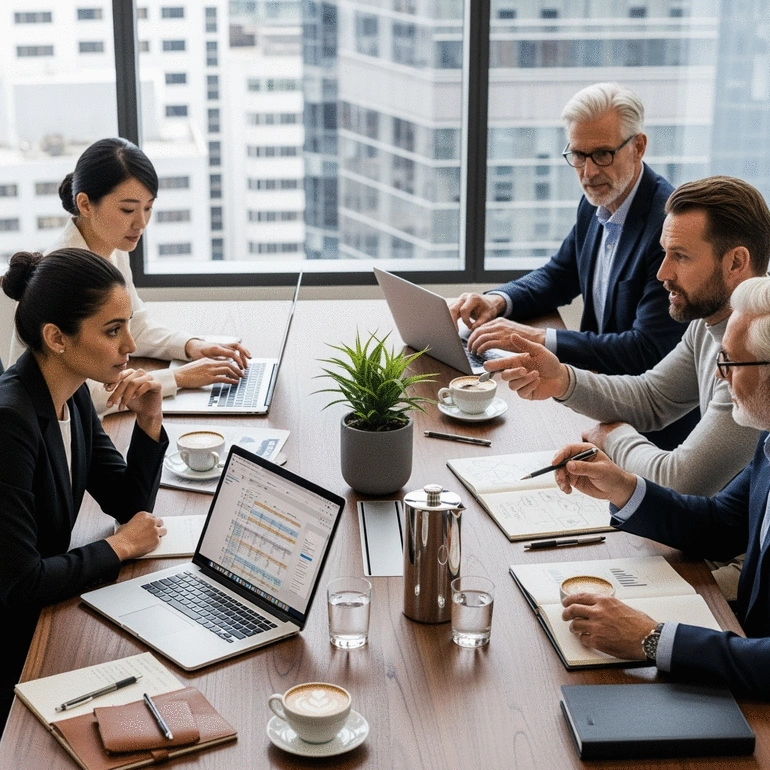Hybrid Work Models
Combining remote and in-office work for flexibility and connection.

As Melbourne navigates the future of work, businesses face a pivotal opportunity to reshape their operations. With a blend of flexibility, technology, and sustainability, the evolving landscape calls for a proactive approach. Are you ready to embrace these changes and lead your team into a thriving future?
The future of work in Melbourne's CBD is characterized by several evolving trends. The visual below highlights the primary shifts businesses are navigating, driven by technological advancements and changing employee expectations.
Combining remote and in-office work for flexibility and connection.
Prioritizing mental health and work-life balance for satisfaction.
Shift to adaptable, high-quality office spaces over sheer quantity.
Leveraging collaboration tools for enhanced productivity and efficiency.
The concept of the future of work is rapidly evolving, especially in the vibrant landscape of Melbourne's Central Business District (CBD). As someone deeply invested in Melbourne’s culture and lifestyle, I’ve observed how local businesses are adapting to shifting norms and expectations. This transformation is fueled by advancements in technology, changing employee desires, and the increasing emphasis on sustainable practices.
In this section, we will explore what the future of work means for businesses in our city. It’s not just about remote work or flexible hours; it’s about rethinking how we approach productivity, collaboration, and community in our urban environment!
For local businesses in the Melbourne CBD, embracing the future of work can lead to significant benefits. A more flexible work environment can enhance productivity and employee satisfaction, ultimately driving growth. The Melbourne Economy Snapshot provides further insights into the economic climate supporting these changes. Here are a few key implications:
These shifts reflect a commitment to building a work culture that not only meets the needs of the current workforce but also attracts future talent to our beloved CBD.
Several key trends are emerging as we navigate this new work landscape. One prominent trend is hybrid working, which allows employees to split their time between the office and remote locations. This model offers flexibility while maintaining a sense of connection to the workplace. The Victorian Chamber of Commerce and Industry highlights how return-to-office trends are stabilizing, suggesting a sustained adoption of hybrid models. Some of the other notable trends include:
As we adopt these trends, it's crucial for local businesses to remain agile and responsive to continued changes in the workforce.
Digital transformation is not just a buzzword; it's driving significant changes in workforce dynamics in Melbourne's CBD. As businesses embrace new technologies, they’re discovering innovative ways to engage employees and streamline operations. The impacts of this transformation are clear:
It’s exciting to see how Melbourne's workforce is evolving through these advancements, ultimately creating a more dynamic and responsive business environment. As we continue exploring these trends, I invite you to consider how your own workplace can adapt and thrive!
As Melbourne's work culture shifts, consider implementing regular feedback loops with your team. This not only encourages open communication but also helps identify areas where employees feel they need more support or flexibility. By actively engaging with your staff, you can create a more inclusive and responsive work environment that embraces the future of work.
As we've explored the evolving landscape of work in Melbourne's CBD, several key trends and opportunities stand out. These insights not only shape our understanding of the future of work but also highlight the essential steps local businesses must take to thrive in this dynamic environment. For a deeper academic perspective on the future of work, you can refer to research published in the Journal of Employment Counseling.
In summary, the rise of hybrid working models, the emphasis on employee wellbeing, and the demand for high-quality office spaces are pivotal. These trends encourage businesses to adapt and innovate, ensuring they remain competitive. Let’s recap some of the major themes:
It's clear that as we move forward, understanding these trends will be vital for businesses aiming to connect with employees and customers effectively. Whether it’s through tailored hybrid models or innovative workspace designs, the future of work in Melbourne's CBD is bright and full of promise!
Now that we've identified the trends shaping our work culture, it's time for local businesses to take action. Embracing the evolving work landscape is essential for survival and growth in Melbourne's Central Business District. It’s crucial to adapt strategies that align with current expectations and demands.
Here are a few practical steps businesses can take to engage with the future of work:
By taking these proactive steps, you can ensure that your business not only survives but thrives in the new work environment. Remember, adapting to change isn't just a necessity—it's an opportunity!
I invite you to share your thoughts and experiences regarding the future of work in the Melbourne CBD! How are you adapting to these changes? What challenges are you facing? Join the conversation and let’s work together to shape a brighter future for our businesses and community.
Here is a quick recap of the important points discussed in the article:
Melbourne CBD Insights is dedicated to empowering you with expert advice and practical guides for navigating life in Melbourne's vibrant Central Business District. We focus on sustainable living and local insights to help you thrive.
